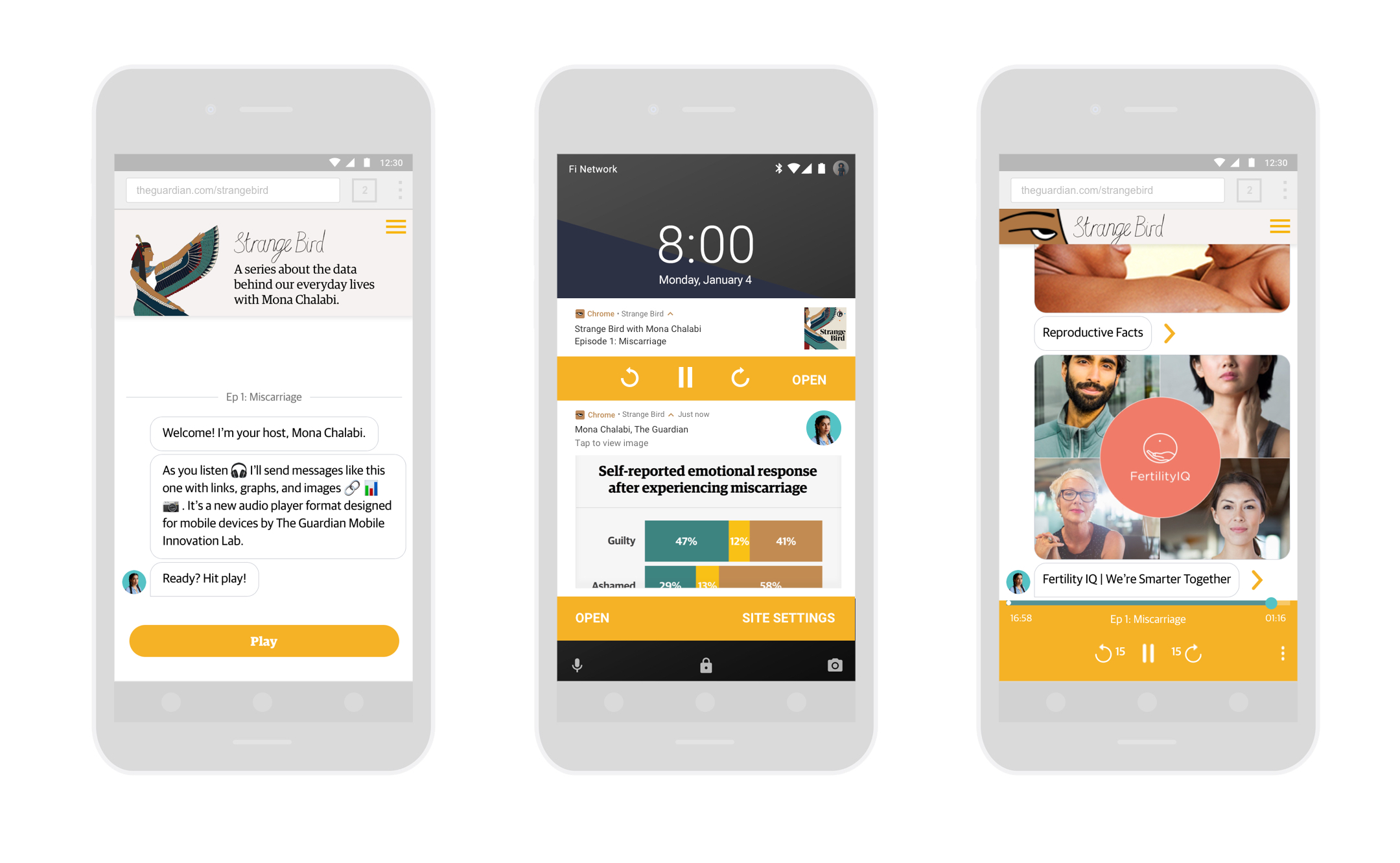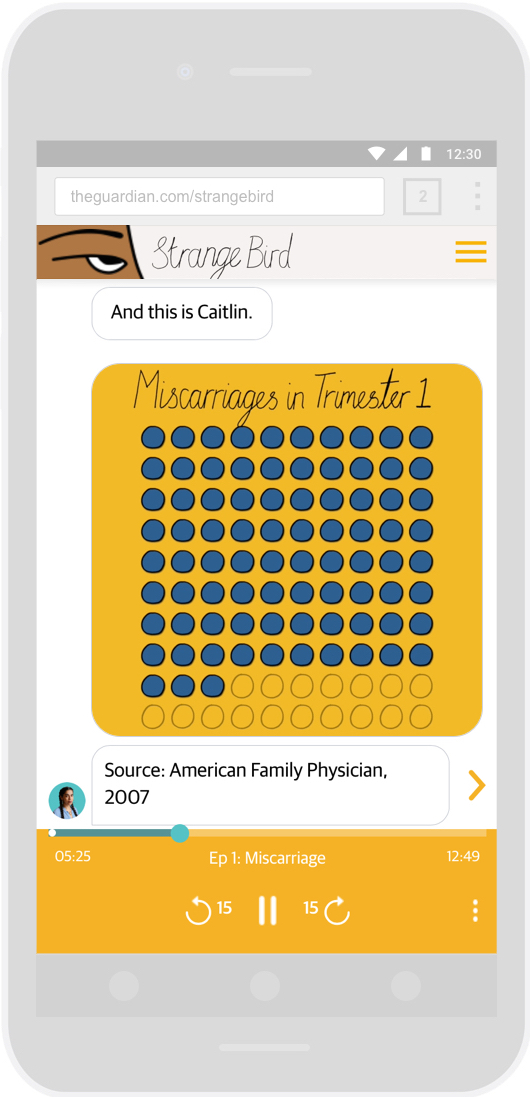
Sometimes, the podcast isn’t enough. Or to put it differently, it’s so good you want to find out even more.
While binging on the S-Town podcast last year, the first thing I did after one episode was search the Internet for more about the central character John McLemore, in hopes of finding a picture of the hedge maze via the GPS coordinates McLemore started giving out. (If you haven’t listened to S-Town and plan to, don’t do this.)
So did the Guardian Mobile Innovation Lab team — an impulse that they guessed many podcast listeners shared. The Lab’s latest mobile experiment is an attempt to address some of the small inconveniences and limitations of the podcast listening experience as it stands today. It’s a podcast player designed for the mobile web, which is being tested first with a new Guardian podcast called Strange Bird, hosted by data editor Mona Chalabi. (The Mobile Innovation Lab and Nieman Lab both receive Knight Foundation funding. You can check out their product process on that Lab’s Medium page, or find Nieman Lab’s coverage of their past experiments here.
 Any listener can access the player through any browser on Apple or Android, though Android users get the added option of turning on push alerts timed to different parts of the audio as the podcast plays on. It’s like podcast show notes, but in real time, and with phone notifications that point you to links and graphics at relevant points in the story. Chrome users can also sign up to get alerts when a new episode is available, without subscribing within a dedicated listening app.
Any listener can access the player through any browser on Apple or Android, though Android users get the added option of turning on push alerts timed to different parts of the audio as the podcast plays on. It’s like podcast show notes, but in real time, and with phone notifications that point you to links and graphics at relevant points in the story. Chrome users can also sign up to get alerts when a new episode is available, without subscribing within a dedicated listening app.
“We had a lot of debates about the purity of audio, and the power a good audio story has. We’re trying to play around with the idea: If it weren’t just audio, what could it be? How can we seamlessly deliver additional media assets?” Sarah Schmalbach, the senior product manager at the Lab, said. “We’re not building an entire experience around them, but adding them where they’re relevant, and taking into account that some people also like to keep the visual or other elements a mystery. We wanted to figure out how to blend a couple of different formats together, with audio as the anchor.”
“We’re seeing so many organizations take interest or invest money in podcasts as a source of gaining new audiences, but those aren’t necessarily integrated into the rest of their output,” Sasha Koren, the Mobile Lab’s editor, said. “Maybe they’re available through a basic web player, but you can’t follow or interact with them in any other way, or you can only access them on a podcast app which takes you off platform.”
Have you ever listened to a podcast episode centered around a visual, heard the host mention the website where some of the images in question live, and then never actually followed up with those extra steps to see the extra stuff? For the wonkier among you, have you ever listened to charts getting cited and papers getting quoted, and wanted to check out the data for yourself? The Mobile Lab’s web player experiment addresses some of these use cases for more regular podcast users. It also attempts to both simplify and enhance the podcast listening process for beginners — especially Android users — who are faced with a range of paid and free listening apps, of varying quality.
 Strange Bird’s premise is that it will use data to open up difficult issues that are actually common, but insufficiently discussed, making it a useful test case for the Mobile Lab’s web player. The Mobile Lab team worked off of the show script to look for possibilities where added material made sense — where there were characters whose photos listeners might be interested in seeing or data graphics Chalabi created that might be incorporated, Koren said. Its pilot episode is on miscarriage, and will feature chats from Mona herself, links to other stories, and illustrations. The podcast will also be available all the other places where podcasts are found, but the web player audio will include a little introduction about the added features.
Strange Bird’s premise is that it will use data to open up difficult issues that are actually common, but insufficiently discussed, making it a useful test case for the Mobile Lab’s web player. The Mobile Lab team worked off of the show script to look for possibilities where added material made sense — where there were characters whose photos listeners might be interested in seeing or data graphics Chalabi created that might be incorporated, Koren said. Its pilot episode is on miscarriage, and will feature chats from Mona herself, links to other stories, and illustrations. The podcast will also be available all the other places where podcasts are found, but the web player audio will include a little introduction about the added features.
“What we’ve created is a sort of augmented traditional podcast,” Alastair Coote, the Mobile Lab’s developer, said. “You can listen to it the way you would a normal podcast, you can engage with the extra bit if you want to.” The web podcast player is a proof-of-concept for the Lab, which is winding down its two-year grant period, but other publishers with resources may want to build on ideas around better podcast listening experiences without a dedicated app (choose your-own-adventure interactive podcasts, perhaps, Coote and Schmalbach suggest).
Some technical roadblocks remain — for instance, if you get an alert that a new podcast episode is posted, and want to tap to download that episode in the background over wifi for future listening offline, you can’t. (Coote outlined a few of these challenges in his own writeup of the podcast player concept from last summer.)
Both platforms and news organizations have experimented with various efforts to give listeners interactivity on top of audio. The investigative reporting show Reveal has offered users the option of texting with the show at given points when it has document excerpts, images, or data to show listeners. The New York Times now offers its morning show The Daily within its app, and listeners can tap around to other stories as the audio continues to play. Last month Spotify announced it would roll out a feature in the app called Spotlight that would show listeners “contextual visual elements, such as photos, video and text, that appear as users move through each episode,” first with partners like BuzzFeed News and Gimlet Media.
Verrry interested to see this new podcast + visuals thing Spotify announced, particularly @BuzzFeedNews and @cheddar use. Despite launch press I can't find any sign of it in the iOS app. https://t.co/OC0lnGX64O
— Sasha Koren (@SashaK) January 23, 2018
The Mobile Lab’s idea is, as always, to get others in the industry thinking about prototypes they’ve built: “We’d love to see more people experimenting with this stuff,” Schmalbach said.